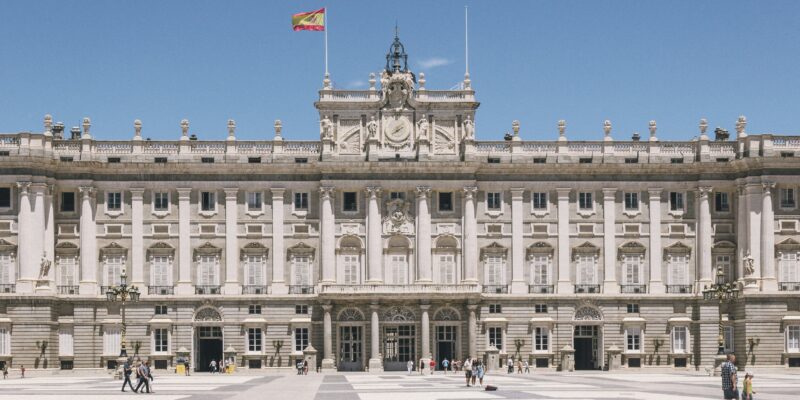
The Royal Palace of Madrid, known as Palacio Real, is one of Spain’s most significant and grandiose landmarks. This stunning building, located in the heart of Madrid, serves as a symbol of the country’s royal history and architectural splendor. Originally constructed in the 18th century, it has been a key site for various historical events and continues to play an essential role in Spain’s cultural and royal traditions.
The palace was built on the site of the old Alcázar, a Moorish castle that was destroyed by fire in 1734. King Philip V commissioned the new palace, envisioning a residence that would epitomize the power and opulence of the Bourbon dynasty. The result is a masterpiece of neoclassical architecture, designed by Italian architect Filippo Juvarra and later completed by his successors. The Royal Palace of Madrid is renowned for its grand façade, which features intricate detailing and a striking presence that commands attention.
One of the most notable aspects of the Royal Palace is its entrances. The palace features several grand entryways, each with its own unique design and historical significance. The primary entrance, located at the Plaza de la Armería, is particularly impressive. This grand gateway is flanked by ornate columns and decorated with elaborate sculptures that reflect the royal heritage of the building. As visitors approach this entrance, they are greeted by the grandeur of the palace, setting the tone for the opulence that lies within.
The entrances of the Royal Palace of Madrid are not just functional points of access but also architectural highlights that showcase the palace’s regal character. The main entrance leads to a magnificent staircase that ascends to the palace’s grand halls. The detailed craftsmanship of the ironwork, the majestic columns, and the sculptural elements all contribute to the palace’s stately presence. Each entrance serves as a testament to the skill and artistry of the architects who designed them, providing a glimpse into the grandeur of Spain’s monarchy.
Inside the Royal Palace, visitors are greeted by an equally impressive array of rooms and spaces. The palace boasts over 3,000 rooms, each more opulent than the last. The grand Hall of Mirrors, for example, is a spectacular space that showcases the height of royal luxury. Its mirrored walls and elaborate chandeliers create a dazzling effect that highlights the wealth and sophistication of the Spanish monarchy. The Royal Chapel, another notable room, is adorned with intricate frescoes and lavish decorations, further illustrating the palace’s artistic and cultural significance.
The Throne Room, one of the most important rooms in the palace, is used for official ceremonies and state events. This room is a prime example of the palace’s elaborate interior design, with its rich tapestries, ornate ceilings, and magnificent chandeliers. It is here that the Spanish royal family hosts important state functions, continuing the tradition of using the palace as a central hub for royal activities.
In addition to its architectural and historical significance, the Royal Palace of Madrid is also home to a vast collection of art and antiques. The palace’s art collection includes works by renowned artists such as Goya, Velázquez, and Caravaggio. These masterpieces are displayed throughout the palace, adding to the cultural richness of the site. The collection also includes a range of antique furnishings, tapestries, and decorative objects that reflect the luxurious lifestyle of the Spanish monarchy.
The Royal Palace’s gardens and surrounding grounds are also worth noting. The Sabatini Gardens, located to the west of the palace, offer a serene escape from the bustling city. These beautifully landscaped gardens feature neatly trimmed hedges, elegant fountains, and tranquil pathways, providing a picturesque setting for visitors to enjoy.
The Royal Palace of Madrid is not only a historical and architectural marvel but also a living symbol of Spain’s royal heritage. It continues to serve as the official residence of the Spanish royal family, although it is primarily used for ceremonial purposes. The palace remains a focal point for national celebrations, state visits, and other significant events, maintaining its role as a key player in Spain’s royal traditions.
Visitors to the Royal Palace can explore its many rooms and halls, gaining insight into the opulent lifestyle of the Spanish monarchy. Guided tours are available, providing detailed explanations of the palace’s history, architecture, and art collection. The palace’s significance extends beyond its physical grandeur; it represents the rich cultural and historical legacy of Spain, offering a captivating glimpse into the nation’s royal past.
In summary, the Royal Palace of Madrid stands as a majestic testament to Spain’s royal heritage and architectural excellence. Its grand entrances, lavish interiors, and rich historical background make it a remarkable destination for those interested in exploring the splendor of Spanish royalty. Whether admiring the intricate details of the palace’s design or learning about its storied past, visitors are sure to be enchanted by the grandeur and significance of this iconic landmark.







